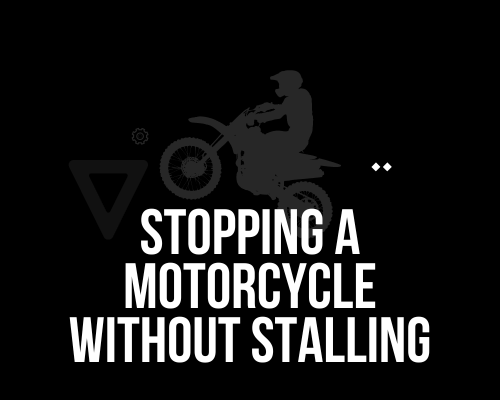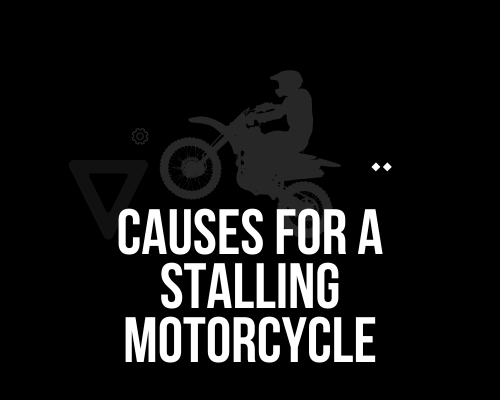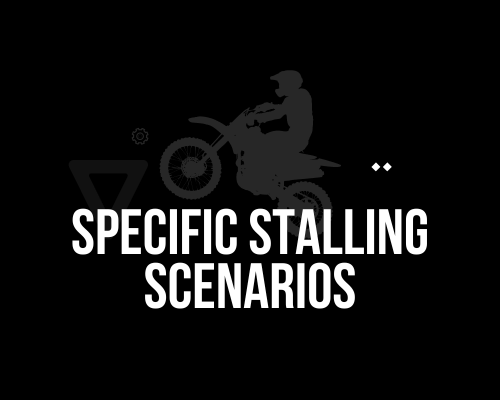This is for every new rider out there who has stalled their bike at least once. I know it can be concerning, wondering if you’ve damaged your motorcycle and if you’re going to get stuck next time you stall your bike; but don’t worry! I’m here to help.
In this article, we’re going to cover over the basics of a stalling motorcycle. From rider skills, to related mechanical and ignition issues, we’ll go over it all.
If you’re worried if it’s bad to stall a motorcycle, I’ll cover if stalling your motorcycle will affect the bike’s reliability. Then we’ll cover some technical details as to what can cause your motorcycle to stall and what you can do as a rider to prevent stalling.
Lastly, as additional information, we’ll cover these specific motorcycle stalling scenarios:
- Why Does My Motorcycle Stall Unexpectedly at Idle?
- Why Does My Motorcycle Stall When I Give it Gas
- Why Does My Motorcycle Stall When Accelerating?
- Why Does My Motorcycle Stall At Idle When Warm?
- Why Does My Motorcycle Stall When Slowing Down?
Anyways, let’s get going!
Is It Bad To Stall A Motorcycle?
Stalling a motorcycle is not inherently bad, but it is definitely not ideal. If you stall your motorcycle frequently, you may be putting unnecessary stress on some of the bike’s components, such as the chain and sprockets. Over time, this can lead to premature wear and tear. Additionally, stalling your motorcycle can create a safety risk, especially if you’re in traffic.

How To Stop A Motorcycle Without Stalling
The key to avoiding a motorcycle stall is proper clutch control. Here are some tips to stop your motorcycle without stalling:
- Start by putting the bike in neutral. With the engine running, gently apply the front brake to stabilize the bike.
- Next, shift your weight to your right foot, which will allow you to use your left hand to pull in the clutch and downshift from neutral to first gear.
- Slowly release the clutch while gradually applying the throttle. Watch your tachometer to make sure you’re not revving the engine too high.
- As you reach the “friction zone” (where the clutch starts to engage), continue to release the clutch while applying more throttle. The bike will start to move forward.
- Once you’ve reached a good speed, you can release the clutch completely and continue to ride.
Proper Clutch Usage When Riding
The name of the game here is modulating the power that is transferred from the engine to the rear wheel. Ultimately, a motorcycle engine will stall if the engine is not spinning at a speed high enough to overcome the force of a stationary bike.
So how do we moderate the power going to the rear wheel of the bike?
- Practice utilizing the friction zone.
The friction zone is the area in which the clutch begins to re-engage the engine – in other words, this is the area where the motorcycle starts to move. Utilizing this will allow you to accelerate slowly with the throttle closed. Since motorcycles stall most frequently in low-speed scenarios, I would say this is the most common reason for a stalling motorcycle; and therefore, you would benefit the most from practicing this technique. It will give you more confidence in low-speed areas like parking lots and roads during heavy traffic. - Practice using the rear brake.
Similar to utilizing the friction zone to move the bike, the rear brake can also be used to regulate the power that is going to the rear wheel of the bike. Using the rear brake pedal in low-speed scenarios will allow you to balance the bike, which will make it easier to maneuver at low speed, and reduce the risk of stalling the bike. While not the same technique, it is very similar to the technique involved in using the friction zone. You will want to start with using less to see how the bike reacts, but over time you’ll be more comfortable in using it. - Practice proper throttle control.
Throttle control is one of the more direct methods of controlling the power to the rear wheel of the bike. If you’re comfortable with using the rear brake, and properly utilizing the friction zone, you’re essentially covered in low-speed scenarios, but you’ll want to be sure that you can accelerate smoothly when entering higher paced environments.
Related: Why Is My Motorcycle Losing Power When Accelerating?
How Does A Motorcycle Clutch Work?
The clutch is an important component of your motorcycle, as it allows you to engage and disengage the engine from the transmission. When you pull the clutch lever, the clutch plates are disengaged, which means that the engine is spinning independently of the transmission. As you release the clutch, the plates begin to engage, transferring power to the transmission and eventually to the rear wheel.
[Recommended Article: How To Diagnose & Trouble Shoot a Harley Davidson No Spark Condition]

[Related: Harley Charging System Diagnostics Guide]
Potential Causes of A Stalling Motorcycle
There are a number of reasons why your motorcycle might stall, from mechanical issues to rider input. In each case, it’s likely the first symptom will be a sputtering when accelerating the bike. Here are a few potential causes:
Related: Lean Fuel Mixture Symptoms
A Vacuum Leak
A vacuum leak can occur if there is a crack or hole in the intake manifolds. This can disrupt the air-fuel ratio, which will cause your motorcycle to lose power and eventually stall.
A Dirty Air Filter
Similar to a vacuum leak, a clogged air filter can also disrupt the air-fuel ratio, leading to a stalled engine. If your bike is stalling frequently, be sure to check the air filter and replace it if necessary.
Related: Motorcycle Wont Idle? Know This
Clutch Related Problems
A number of clutch-related problems could also be to blame for a stalled motorcycle:
Worn Clutch Plates
The clutch plates are designed to allow power to be transferred from the engine to the gearbox. If these plates are worn, they may not be able to grip together properly, which can result in a stalled engine.
Clutch Cable Needs Adjustment
Another potential issue is that the clutch cable may need adjustment. Over time, the cable can stretch, which can lead to an inability to disengage the clutch completely. As a result, the motorcycle may stall.
Throttle Related Problems
There are a few throttle-related problems that can lead to a stalled motorcycle:
Worn Throttle Cable
If your throttle cable is worn or has too much slack, it can prevent the carburetor from opening properly. As a result, the engine might not receive enough fuel, which can lead to a stalled motorcycle.
Throttle Position Sensor Needs Calibration
Another potential issue is that the throttle position sensor may need calibration. This sensor sends signals to the engine’s computer, which regulates the amount of fuel injected into the engine. If the sensor is not calibrated correctly, it may not be able to provide accurate information, leading to a stalled engine.
Idle Speed Is Out of Adjustment
If your motorcycle stalls at idle, it could be that your idle speed is out of adjustment. Most bikes idle between 750 and 1500 RPM, so if your bike is idling below this range, it might be struggling to stay running.
Fuel System Related Problems
There are many fuel related problems that plague motorcycles. Typically, fuel system problems can prevent your motorcycle from receiving enough fuel to keep the engine running, or your motorcycle won’t start at all:
Clogged Fuel Filter
The fuel filter is responsible for removing any contaminants from the fuel before it enters the engine. If the filter is clogged, it can restrict the flow of fuel, which can lead to a stalled engine.
Clogged Fuel Injectors
In some cases, the fuel injectors may also become clogged. This will prevent fuel from being sprayed into the engine, which can result in a stalled engine.
Dirty Fuel Tank
Lastly, if your fuel tank is dirty, it can prevent fuel from flowing to the engine. If you suspect this is the case, you may need to have the tank cleaned or replaced.
[Recommended Read: Saving Yourself From A Motorcycle Speed Wobble]

Specific Stalling Motorcycle Scenarios
There are a few common scenarios where your motorcycle might stall:
- Motorcycle Stalling Unexpectedly at Idle
This could be due to an issue with the idle speed, the idle air control valve, or the throttle position sensor. If your bike stalls at idle, it’s important to check these components to make sure they are functioning properly.
- Motorcycle Stalling When Given Gas
If your motorcycle stalls when you give it gas, it could be due to a clogged fuel filter, a dirty air filter, or a vacuum leak. It’s important to check all of these components to determine the root cause.
- Motorcycle Stalling When Accelerating
If your motorcycle stalls when accelerating, it could be due to a worn clutch, a faulty throttle position sensor, or a clogged fuel filter. Be sure to check these components to identify the problem.
- Motorcycle Stalling At Idle When Warm
If your motorcycle stalls at idle when the engine is warm, it could be due to a problem with the idle speed, the idle air control valve, or the throttle position sensor. All of these components should be inspected to determine the cause.
- Motorcycle Stalling When Slowing Down
If your motorcycle stalls when slowing down, it could be due to a problem with the clutch, the throttle, or the fuel system. All of these components should be checked to determine the root cause.